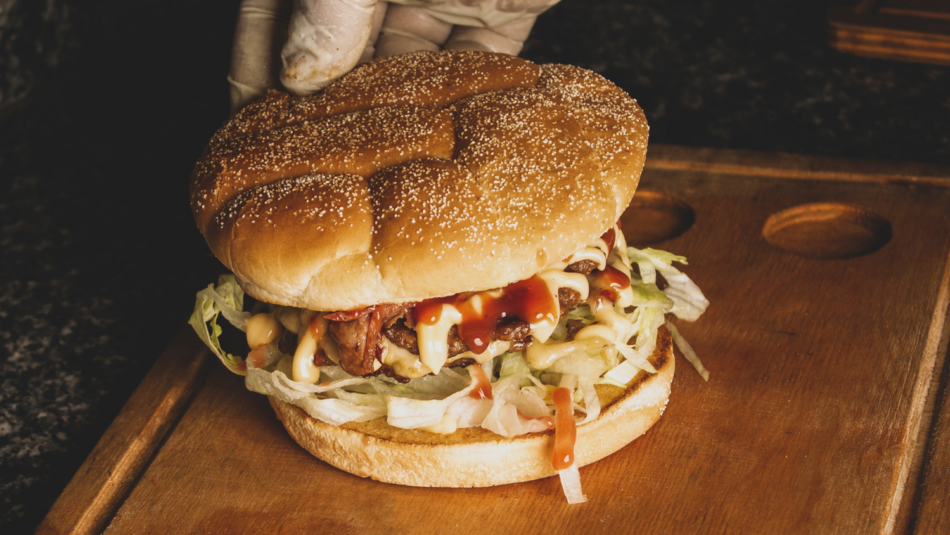If you find yourself in northwestern North Carolina with a hankering for something tasty, consider its namesake, Surry Ground Steak. It’s a Depression-era sandwich recipe, much like the Mississippi Slugburger, that was originally developed to get around the cost of meat and stretch it a little further. Instead of incorporating soybeans or cornmeal like the Slugburger, this dish incorporates a flour-based roux that because almost a barbecue sauce-like paste. Today, it’s a delicacy, a tradition, and a cornerstone of local and regional culinary pride.
And yes, you can make it yourself! The method of making Surry Ground Steak borrows techniques from a typical Sloppy Joe or Salisbury steak, but a big scoop of meat alone does not a Surry County steak make; a tangy, North Carolina-style slaw ties the whole sandwich together, typically with a tomato or slice of yellow onion. Read on for more of its history, and learn how to make it at home.
The Surry County Ground Steak Trail
From BBQ Trails and Tamale Trails in Mississippi to the Midland-Odessa Taco Trail in Texas, food tourism is a booming industry across many regions of the South. The Surry County Ground Steak Trail is one such offering, a digital guide to destination restaurants across the state that serve a version of the regional classic: a loose crumble of juicy, seasoned ground beef, a tangle of tangy coleslaw, and a bright red tomato on a hamburger bun. (Surry County is also home to a famed Sonker Trail, which celebrates the origins of a unique Southern dessert that bears a resemblance to a cobbler.)
While the general gist of the dish is always the same, the way it is actually prepared and served can vary widely. “The more ground steak I ate, the less I felt I knew about it,” says Hanna Raskin, who recorded her experience on the trail for ‘The Assembly,‘”since every restaurant has its own ideas about proper shape, size, texture, and seasoning.”
The History of Surry Ground Steak
Accounts of the first Surry Ground Steak trace back to the Canteen Restaurant in Mount Airy, a small town in Surry County, North Carolina, near the Virginia border. Ground steak was traditionally prepared on a cast-iron skillet until ground beef crumbled and browned easily, then separated in the skillet from the grease. Flour would be added to the grease to make a roux, which is incorporated back into the ground beef to bind it together as loosely formed patties.
While Canteen is now closed, numerous diners and restaurants in the region have continued its tradition. In an article for the “Mount Airy News,” Canteen cook Bob Ward remembers how the dish and its name came to be. “Ward said The Canteen often called it ‘steak and gravy,’ but it was the same as the ground steak,” the article reads, “and many people who ate there asked for a ‘ground steak sandwich’ instead of calling it ‘steak and gravy’ as it was referred to on the menu that hung in The Canteen.”
The Surry County Ground steak is in fact similar to Salisbury steak, or a proper fried Steak N Gravy, but ground steak is more akin to a burger or a barbecue sandwich—served in a casual jumble, on bread, with toppings. The name stuck, and so did the preparation.
How to Make Surry County Ground Steak
These days, it’s more common to find Surry Ground Steak at one of the meat-and-threes, barbecue restaurants, or local establishments on the aforementioned and illustrious trail; however, some folks still make it at home themselves. The basic recipe is simple, and while it varies a bit depending on preference and taste, it must include coleslaw.
And when it comes to ratios, most recipes include about 2 pounds of ground chuck to roughly 1/4 cup of flour, but you can alter this ratio to your liking—more or less flour, depending on how much beef you have. The beauty of the recipe is that it is designed to be economical. Simply adjust the amounts of each depending on what you have on hand.
Ingredients
- Ground beef. Opt for ground chuck beef (80/20) which has a higher fat content. This ensures that the fat renders from the beef, which helps develop the flour-based roux. It also provides a base level of fat for the patty to fry easily.
- Salt, black pepper, and other seasonings to taste. Salt and black pepper are the typical seasonings, but some recipes dress it up with Worcestershire sauce for extra nuttiness and flavor.
- All-purpose flour.
- Hamburger buns, for serving.
- North Carolina-style coleslaw. This is the coleslaw that’s served alongside eastern North Carolina barbecue. It’s tart, crisp, and a little creamy—but not too much. To replicate it, whip up a vinegar coleslaw or a creamy, tangy Southern-style coleslaw that incorporates mustard, celery seeds, mayonnaise, and vinegar.
- Tomato or onion, for serving. Tomato and onion are optional, but you’ll find that they add extra texture—and color—to the otherwise beige-and-brown meal!
Dotdash Meredith Food Studios
Directions
- Brown beef. Cook ground beef with salt and pepper in a large cast iron skillet over medium heat to let the fat render slowly. Once the beef is browned—and even slightly crispy—push it to the side of the cast iron skillet, or transfer it with a slotted spoon to a plate to set aside.
- Make roux. Add flour to the grease and cook, stirring often, until bubbling, golden brown, and aroma is nutty and fragrant—this creates a roux. Add more salt and pepper to taste.
- Stir together. Add beef to the roux and stir until incorporated and sizzling. Carefully use a spatula or spoon to form the beef mixture into small patties, if desired.
- Serve. Scoop mixture onto hamburger buns and serve with coleslaw, tomato, and onion.








